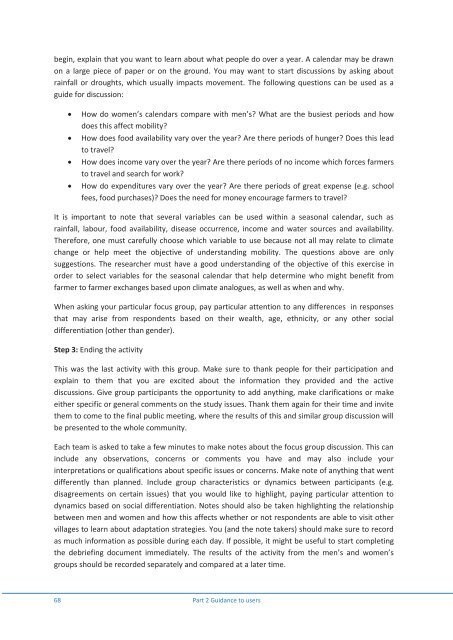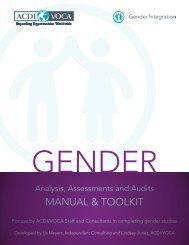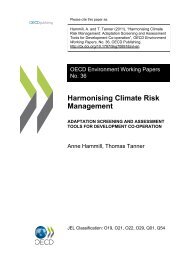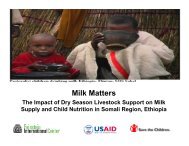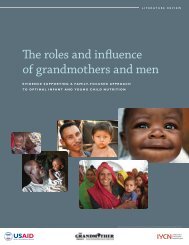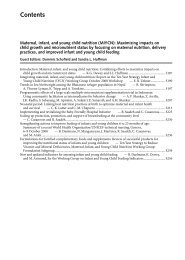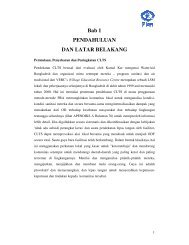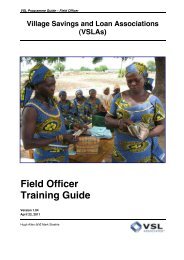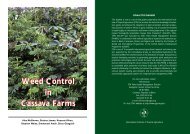Gender and climate change research in - FAO
Gender and climate change research in - FAO
Gender and climate change research in - FAO
You also want an ePaper? Increase the reach of your titles
YUMPU automatically turns print PDFs into web optimized ePapers that Google loves.
eg<strong>in</strong>, expla<strong>in</strong> that you want to learn about what people do over a year. A calendar may be drawn<br />
on a large piece of paper or on the ground. You may want to start discussions by ask<strong>in</strong>g about<br />
ra<strong>in</strong>fall or droughts, which usually impacts movement. The follow<strong>in</strong>g questions can be used as a<br />
guide for discussion:<br />
<br />
<br />
<br />
<br />
How do women’s calendars compare with men’s What are the busiest periods <strong>and</strong> how<br />
does this affect mobility<br />
How does food availability vary over the year Are there periods of hunger Does this lead<br />
to travel<br />
How does <strong>in</strong>come vary over the year Are there periods of no <strong>in</strong>come which forces farmers<br />
to travel <strong>and</strong> search for work<br />
How do expenditures vary over the year Are there periods of great expense (e.g. school<br />
fees, food purchases) Does the need for money encourage farmers to travel<br />
It is important to note that several variables can be used with<strong>in</strong> a seasonal calendar, such as<br />
ra<strong>in</strong>fall, labour, food availability, disease occurrence, <strong>in</strong>come <strong>and</strong> water sources <strong>and</strong> availability.<br />
Therefore, one must carefully choose which variable to use because not all may relate to <strong>climate</strong><br />
<strong>change</strong> or help meet the objective of underst<strong>and</strong><strong>in</strong>g mobility. The questions above are only<br />
suggestions. The <strong>research</strong>er must have a good underst<strong>and</strong><strong>in</strong>g of the objective of this exercise <strong>in</strong><br />
order to select variables for the seasonal calendar that help determ<strong>in</strong>e who might benefit from<br />
farmer to farmer ex<strong>change</strong>s based upon <strong>climate</strong> analogues, as well as when <strong>and</strong> why.<br />
When ask<strong>in</strong>g your particular focus group, pay particular attention to any differences <strong>in</strong> responses<br />
that may arise from respondents based on their wealth, age, ethnicity, or any other social<br />
differentiation (other than gender).<br />
Step 3: End<strong>in</strong>g the activity<br />
This was the last activity with this group. Make sure to thank people for their participation <strong>and</strong><br />
expla<strong>in</strong> to them that you are excited about the <strong>in</strong>formation they provided <strong>and</strong> the active<br />
discussions. Give group participants the opportunity to add anyth<strong>in</strong>g, make clarifications or make<br />
either specific or general comments on the study issues. Thank them aga<strong>in</strong> for their time <strong>and</strong> <strong>in</strong>vite<br />
them to come to the f<strong>in</strong>al public meet<strong>in</strong>g, where the results of this <strong>and</strong> similar group discussion will<br />
be presented to the whole community.<br />
Each team is asked to take a few m<strong>in</strong>utes to make notes about the focus group discussion. This can<br />
<strong>in</strong>clude any observations, concerns or comments you have <strong>and</strong> may also <strong>in</strong>clude your<br />
<strong>in</strong>terpretations or qualifications about specific issues or concerns. Make note of anyth<strong>in</strong>g that went<br />
differently than planned. Include group characteristics or dynamics between participants (e.g.<br />
disagreements on certa<strong>in</strong> issues) that you would like to highlight, pay<strong>in</strong>g particular attention to<br />
dynamics based on social differentiation. Notes should also be taken highlight<strong>in</strong>g the relationship<br />
between men <strong>and</strong> women <strong>and</strong> how this affects whether or not respondents are able to visit other<br />
villages to learn about adaptation strategies. You (<strong>and</strong> the note takers) should make sure to record<br />
as much <strong>in</strong>formation as possible dur<strong>in</strong>g each day. If possible, it might be useful to start complet<strong>in</strong>g<br />
the debrief<strong>in</strong>g document immediately. The results of the activity from the men’s <strong>and</strong> women’s<br />
groups should be recorded separately <strong>and</strong> compared at a later time.<br />
68 Part 2 Guidance to users


